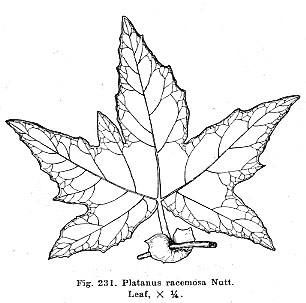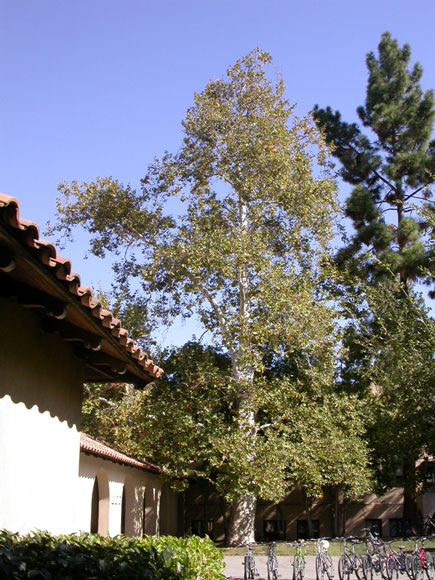Platanus racemosa
 California plane, sycamore
California plane, sycamore

This tree and the buttonwood (Platanus occidentalis) of the Southern and Western states are both called sycamores because of the general resemblance to the European sycamore (Acer pseudoplatanus), but the relationship is remote as evidenced by the 1-inch diameter seed balls that are clearly seen when the leaves fall. European sycamore has the usual keys of a maple; in learning to distinguish these trees it is helpful to think of this one as the California plane tree. Still, nearly everybody calls it a sycamore, and one can wink at the inconsistency seeing that the European sycamore, in turn, has no connection with the original Biblical sycamore (Ficus sycomorus) of Egypt and Asia Minor.

Our sycamore is found along along live streams, around springs, or in gullies with underground water in western California – including Santa Clara County – and Baja California.
The leaves of P. racemosa generally have five lobes, but some have three and could be described as W-shaped. The base of the short leaf stalk is clasped by a distinctively two-pointed green stipule that offers a reliable identification until it drops off; the young leaves unfurl covered with rusty wool, some or much of which can still be found at the junction of the veins of older leaves.
Locations
A noble specimen of massive proportions, 10½ feet in girth, stands on the south side of the Old Union courtyard, just outside the arcade, and five vintage specimens grow on the side edges of Frost Amphitheater’s grand lawn. There are many on Stanford Avenue as it approaches Junipero Serra Boulevard and, more recently, a section of what was Governor’s Avenue acquired about 75 trees spaced 15 feet apart, west of the Center for Clinical Sciences Research. An allée was also planted at the beginning of Governor’s Avenue South and the adjacent parking lot along Campus Drive West. A few line the Escondido Road side of Arrillaga Family Dining Commons.
The most unusual campus specimen, at 524 Gerona Road, was planted by the original homeowners in the late 1930s and trained as a giant bonsai, with the two trunks artistically counterbalancing each other before they soar upward.
About this Entry: The main text of this entry is from the book Trees of Stanford and Environs, by Ronald Bracewell, published 2005. John Rawlings subsequently added the allée location. Native range noted; the Arrillaga Family Dining Commons location added (Mar 2018, SP). Frost count updated (Dec 2024, SP).




